Titan News 2008
December 16, 2008: Some Brightness Variations in Infrared Images of the Same Locations May Reveal an Active Cryovolcanism
In mid December 2008, the American Geophysical Union held a meeting in San Fransisco, California in which the hypothesis for active cryovolcanism on Titan was put forward by Cassini scientists after new analysis of infrared and radar images.
Visible and Infrared Mapping Spectrometer data collected on Titan flybys from July 2004 to March 2006 unveiled changes in brightness and reflectance identified at two separate and distinct regions of Saturn's largest moon. In one of the two areas, the reflectance of the surface, which is the ratio of light that radiates onto it to the amount reflected back, significantly rose and remained higher than expected. In the other region, the reflectance climbed but was then orientated downward. These infrared variations in brightness imply, notably, the hypothesis that the appearance changes were caused by an active icy volcanism or geysers.
Rosaly Lopes, a Cassini radar team investigation scientist from NASA's Jet Propulsion Laboratory in Pasadena, California advanced:" Cryovolcanoes are some of the most intriguing features in the solar system."..." To put them in perspective, if Mount Vesuvius had been a cryovolcano, its lava would have frozen the residents of Pompeii."
Jonathan Lunine, a Cassini interdisciplinary scientist from the Lunar and Planetary Laboratory, University of Arizona, Tucson pointed out:" Cassini data have raised the possibility that Titan's surface is active."..." This is based on evidence that changes have occured on the surface of Titan, between flybys of Cassini, in regions where radar images suggest a kind of volcanism has taken place."
One of the key features in favour of cryovolcanism is the presence of a presumed haze gliding over flow-like surface formations. Is it related to geophysical processes such as springs, geysers or icy volcanoes or meteorological processes such as methane, ethane rain or evaporation ?
If there is volcanism on Titan, it is expected to be a very exotic volcanism because the geological composition of the icy moon is unlike that of the Earth and Titan's environment is very harsh. The material expelled from Titan's crust or volcanoes would rather be made up of volatiles such as methane, ethane, water or ammonia instead of the terrestrial molten rock. Moreover, Titan is not expected to be "very differenciated." In other words, the internal compounds of the largest Saturn moon are not expected to be so much denser than the material of the outer crust, likely composed of water ice, hydrocarbons, ammonia and frozen carbon dioxide . Now, if Titan volcanoes also spew materials from the inner core, we could envisage the presence of traces of molten rock in eruptions. Nevertheless, this scenario is considered very unlikely.
In the views suggesting a cryovolcanic activity, ammonia frost turns out to have been identified at one of the two changing regions. And it is specified that ammonia ( NH3 ) was evident only at times when the area was deduced to be active.
Robert M. Nelson of JPL, a scientist for Cassini's Visual and Infrared Mapping Spectrometer team argued:" Ammonia is widely believed to be present only beneath the surface of Titan." He explained:" The fact that we found it appearing at times when the surface brightened strongly suggests that material was being transported from Titan's interior to its surface."
The relatively abundant methane in the atmosphere of the Orange Moon might well derive from Titan's interior via cryovolcanoes or geysers because in the long run, methane molecules tend to be broken down by ultraviolet light coming from the Sun. Titan's cryovolcanoes may represent a major source of fresh methane supply. Thus, the atmospheric concentration of methane would be maintained by icy volcanoes, acting as a replenishment source for Titan's gas blanket. Scientists claim that without replenishment, Titan's original atmospheric methane should have disappeared long ago.
The hypothesis for cryovolcanism is not the only hypothesis. It is counterbalanced by the meteorological hypothesis. Some scientists argue that brightness changes might not be related to changes on Titan's surface. They could, also, be explained by appearances of ground "fogs" of ethane droplets close to Titan's surface, resulting from atmospheric processes rather than geophysical processes.
Robert M. Nelson pointed out:" There remains the possibility that the effect is caused by a local fog, but if so, we would expect it to change in size over time due to wind activity, which is not what we see."
Titan's opaque atmosphere prevents scientists from concluding upon the presence and the shapes of volcanism on this moon. It is likely that Saturn and the other moons exert "shaking effects" on Titan's geology but is it enough to engender volcanic eruptions or geysers ? If we take a look at other Saturn moons, we notice that most of them don't show any clear sign of geological or volcanic activity. But one of the moons is strongly active for sure: this moon is Enceladus, a small body only 500 km across.
Surprisingly, some strong geysers spraying water molecules appear specifically in the south polar region of Enceladus through what we call "Tiger stripes" or wide topographic fractures. Why in the south pole ? That remains a mystery. But it's a phenomenon which shows that Titan's massive atmosphere can be sustained, over time, by cryovolcanism, a relatively strong gravity and in a relatively cold environment. Some other examples of active worlds can be found in the solar system and especially the moons of Jupiter Io and Europa. But the examples of "inacitve worlds" appear more wide spread.
Jeffrey Moore, a planetary geologist at the NASA Ames Research Center, Moffett Field, California advanced: " Like Callisto, Titan may have formed as a relatively cold body, and may have never undergone enough tidal heating for volcanism to occur." He added:" The flow-like features we see on the surface may just be icy debris that has been lubricated by methane rain and transported downslope into sinuous piles like mudflows."
A radar image obtained on April 30, 2006 clearly shows channel patterns which take the shape of a "quasi network" as if the ice pack of the Arctic, floating over an ocean had been fractured. These sinuous channels are either volcanic channels, rivers or fractures.
Further infrared and radar images will be welcome to refine the study. A new ambitious mission to Titan for the years 2020-2030 is proposed by scientists and notably Athena Coustenis, an astrophysicist and planetologist with the Paris Observatory who suggests to send a hot air balloon to Titan as well as an orbiting spacecraft and a surface probe. The project is called the "Titan and Saturn System Mission" or "TSSM".
Athena Coustenis pointed out: " Titan is the best place to go with a balloon because of the atmosphere."..." We need a Titan-dedicated orbiter because after four years of Cassini, we still haven't mapped more than 25 percent of Titan's surface." She concluded: " When you see the diversity the moon has, you realize it needs full-coverage mapping. And we can have a polar orbiter, whereas Cassini only passes by Titan on the ecliptic."
The hot air balloon would undoubtedly be the ideal probe to spot large scale topographic or geologic features such as cryovolcanoes, mountains, rivers or lakes, the same way the Huygens probe did while it descended once and for all throughout Titan's atmosphere, still raising more questions than answers as always in exploration.
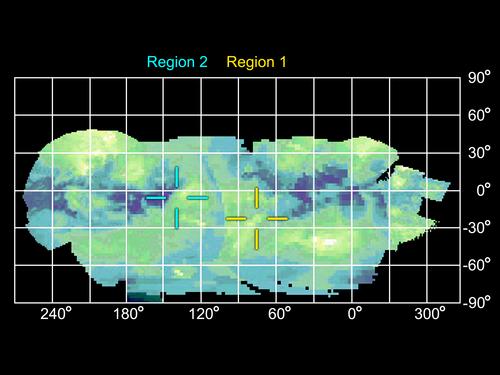
The view above is an infrared projection map of Titan which shows two regions suspected to undergo cryovolcanic activity due to brightness changes in images of the same locations. The blue marking is centered on region 2, a presumed active region and the yellow marking is centered on region 1, another area thought to generate icy volcanism. Image source: NASA, JPL
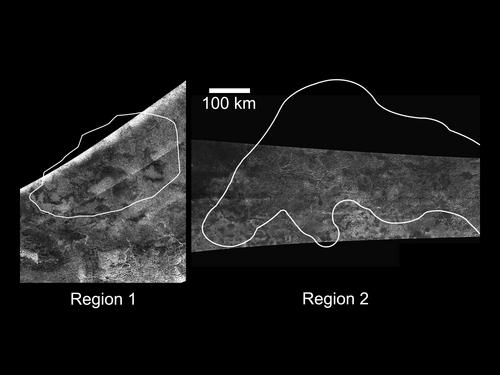
The set of Titan radar images, above, captured by the Radar Mapper of the Cassini spacecraft shows two suspected areas showing a cryovolcanic activity. Some flow-like features in region 1, surrounded by a white line, suggest that they might result from eruptions of volatiles such as methane, ethane, ammonia, water or carbon dioxide. The hypothesis holds because some features of the region changed in brightness in different infrared views. Likewise, Region 2, surrounded by a white line, in the radar image on the right, shows a network of sinuous channels and some infrared views reveal that some features of the area have changed in brightness. It might also be due to cryovolcanism. Image source: NASA, JPL
- To get further information on that news, go to: http://saturn.jpl.nasa.gov/news/newsreleases/20081215titanvolcanoes and http://www.astrobio.net/news/modules.php?op=modload&name=News&file=article&sid=2926
November 3, 2008: Some Spanish Researchers claim they have found Evidence for Lightning in Titan's Atmosphere
Lightning which is a discharge of electricity from charge separation phenomena turns out to occur in most atmospheres in the Solar System according to data gathered by the main planetary probes ( Voyager I and II, Galileo, Cassini or Venus Express ).
The Gas Giants, Jupiter and Saturn are governed by a myriad of cyclones, hurricanes or vortices. And those cyclones, like Earth's thunderstorms, generate flashes of lightning. In 1997, for instance, the Galileo orbiter photographed several optical flashes in Jupiter's storms on similar latitudes. The lightning bolts probably occured in high clouds. The largest bright patch, identified, was approximately 500 kilometers across. In 2001, the Cassini spacecraft, on its way toward Saturn and its moons, also revealed two lightning storms thanks to two images of the same location of Jupiter, one view during the day which showed two storms and one view during the night which unveiled lightning in both storms.
More recently, in 2006, it was reported that Saturn hosted giant lightning storms. In Saturn's dynamic atmosphere, one can encounter electrical storms larger than the continental United-States in which the lightning bolts are more than 1,000 times stronger than ordinary lightning. Cassini's Radio and Plasma Wave Science instrument identified lightning radio emissions from a white cloud at southern latitudes. Georg Fischer said:" With Cassini we have learned that lightning storms can emerge suddenly and last for several weeks or even a month." He added:" On the other hand , we have only observed a single smaller lightning storm throughout 2005, which is remarkably different compared to what we know about terrestrial thunderstorms." The origin of such storms is probably related to Saturn's warm interior.
The Venusian atmosphere also generates flashes of lightning via sulfuric acid clouds. It implies that lightning in Venus's atmosphere is different in nature from lightning found in the atmosphere of Earth, Jupiter and Saturn. Lightning is, indeed, related to water clouds on the two largest Gas Giants and Earth. The finding of electrical discharges in the Venus atmosphere was confirmed with data obtained by the Venus Express magnetometer instrument provided by the Space Research Institute in Graz, Austria. The strongest evidence for lightning sparks on the second closest planet to the Sun came from the impulsive electromagnetic waves detected by Venera 11 and 12 landers. On the Red Planet, Mars, it is believed that charge separation and lightning bolts are possible in the Martian dust storms.
The presence of lightning is intriguing because it strongly acts on the formation of new molecules in the atmosphere by breaking down molecules that recombine to engender new molecules in unexpected ways. Lightning contributes, to a large extent, to indirectly engender complex molecules. In environments where carbon-made molecules such as methane ( CH4 ), hydrogen cyanid ( HCN ) or carbon dioxide ( CO2 ) are wide-spread, lightning may play a key role in producing complex organic molecules or a prebiotic chemistry.
The origin of the complex organic material on Titan is subject, today, to in-depth analysis. The researchers admit that ultraviolet radiations from the Sun have a strong impact on the "atmospheric soup" of Titan via photolysis processes on hydrocarbons such as methane, ethane or acetylene in particular. But lightning bolts, if confirmed, may also play a key role in producing this "lego game" with organic and non-organic molecules.
Physicists at the University of Granada and the University of Valencia ( Spain ) claim that they have demonstrated "in an unequivocal way" that there is natural electric activity in Titan's atmosphere on the basis of their analysis of the data sent by the Huygens probe from Saturn's largest moon.
Juan Antonio Morente, a researcher from the department of Applied Physics of the University of Granada, who reminds that Titan's atmosphere was first identified in 1908 by the Spanish astronomer Josep Comas Solà thanks to limb darkening observations, argued:" In this moon there are clouds with convective movements and therefore there can be static electric fields and stormy conditions."..." It significantly increases the chance that organic and pre-biotic molecules get formed, according to the theory of Russian biochemist Alexander I. Oparin and Stanley L. Miller's experiment."
The Urey-Miller experiment was scientifically fruitful: electric sparks were generated and applied to mixtures of molecules supposed to reproduce the natural conditions of the early Earth ( H2O, CH4, NH3, H2 and CO ) and it managed to synthesize organic compounds from inorganic ones. In other words, the experiment led to the formation of prebiotic molecules such as amino acids, proteins or sugars. That's why the subject of lightning in the unique atmospheric environment of Titan has been closely studied.
Lightning can be detected via global electromagnetic resonances or "Schumann resonances". Venus, Mars, Jupiter, Saturn and Titan appear as candidates for Schumann resonance detection besides the Earth. "Schumann resonances" are characterized by a set of spectrum peaks in the extremely low frequency ( ELF ) portion of the Earth's electromagnetic field spectrum. The space between the surface of the Earth and the conductive ionosphere acts as a waveguide, as a resonant cavity for electromagnetic waves in the ELF band ( Extremely Low Frequency ) and this resonant cavity is naturally excited by energy from lightning discharges which explains the spectrum peaks in the ELF portion of the spectrum.
Two factors to the appearance of these global electromagnetic resonances appear: first, the presence of a significant ionosphere with electric conductivity increasing with height from low values near the surface and second, a source of excitation of electromagnetic waves in the ELF range. The electromagnetic waves show a radial electric field and a tangential magnetic field, with a weak tangential electric field.
The Huygens probe which plunged into Titan's atmosphere on January 14, 2005 carried a special sensor to measure the electric field, the sensor of mutual impedance or MIP. This device was composed of four electrodes, two transmitters and two receptors and there was a couple of transmitter-receptor in each of the pull-down arms end of the spacecraft. The sensor could measure the atmospheric electric conductivity as well as the natural electric field in Titan's atmosphere by acting as a dipole antenna.
Juan Antonio Morente pointed out:" In a stable descent, without rolling, the MIP sensor would have been able to measure the peak tangential component of the electric field."..."But unfortunately a strong wind made the probe roll and the electrodes measured a superposition of such tangential and radial component." As a result, no global electromagnetic resonances or "Schumann resonances" were detected and the electric field spectrums appeared to be relatively flat. However, the Spanish research team reexamined the data and managed to unveil hidden Schumann resonances. They claim they have obtained "the irrefutable proof" of natural electric activity in this hazy and opaque atmosphere. The researchers underline that Titan's atmosphere is an electromagnetic environment with high losses and its resonant cavity is not as clear as that of the Terrestrial atmsophere.
Besides, let's acknowledge that Titan's climate and meteorology is not well understood. On the basis of the VIMS observations ( Visual and Infrared Mapping Spectrometer ), lightning and thunderstorms would tend to occur, more likely in the high southern and northern latitudes, currently, simply because the cloud patterns are concentrated in the polar regions. Some cloud streaks , reminding of Cirrus-like clouds on Earth, can also be spotted at mid-latitudes. Let's notice, also, that Titan clouds are generally composed of ethane or methane contrary to water clouds on Earth. Thus, lightning in Titan's atmosphere would not originate and propagate in the same material as in Earth's atmosphere. The Titan year and its seasons are long which implies that the formation and movements of clouds can change significantly over time. Maybe that lightning strikes are more frequent in specific seasons and places.
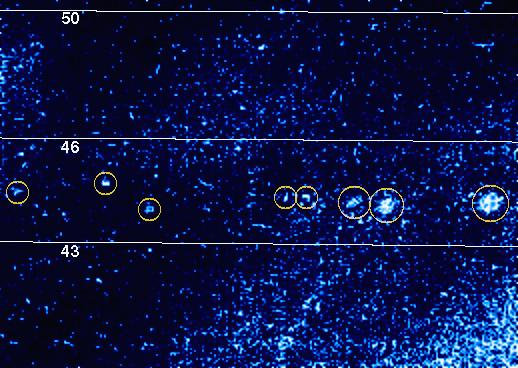
The image above, captured by the Galileo spacecraft in the 90's, shows an optical view of Jupiter revealing flashes of lightning. Each encircled bright patch corresponds to lightning. The largest bright patch is approximately 500 kilometers across and might be related to high clouds illuminated by several bright lightning strokes. Image source: Galileo Project, JPL, NASA
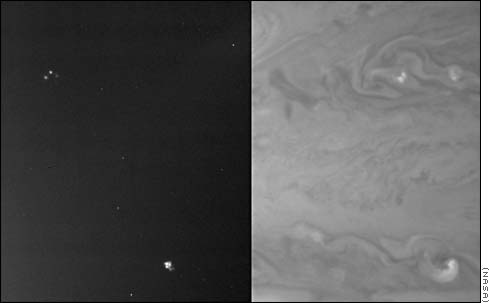
The mosaic of Jupiter views above unveil storms taken during the night and during the day in January 2001. Two major storms ( high altitude clouds ) are clearly visible on the right image during the day. The left image, acquired during the night, suggests that there is an electric activity or lightning in the storms because they are illuminated: they appear as bright patches in this view. Image source: NASA, JPL
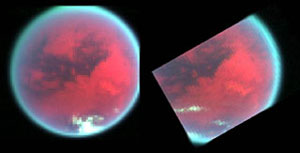
The two false color images of Titan, above, reveal cloud formations over Titan's southern hemisphere: the left image which was obtained on October 26, 2004 unveils a cloudy area over the south polar region and the right image taken on December 13, 2004 unveils cloud streaks over temperate latitudes. The cloud movements seem to be relatively dynamic. Do the cloud formations engender electric activity or lightning ? Image Source: NASA, JPL
- To get further information on that news, go to: http://www.astrobio.net/news/modules.php?op=modload&name=News&file=article&sid=2917&mode=thread&order=0&thold=0
September 16, 2008: Titan's Massive Atmosphere may be protected from the Solar Wind by Saturn's Magnetic Forces
Saturn exerts a strong magnetic field in its environment. Its magnetosphere represents a magnetic shield against solar winds which tend to be deflected in their path by the magnetic loops of the Gas Giant. Titan, which orbits Saturn at a mean distance of about 1.2 million kilometers, lies in a "scientifically interesting" region of the Saturn magnetosphere: it orbits just inside the mean location of the magnetopause, the boundary of the magnetosphere. Most of the time, the largest Saturn moon runs inside the "magnetic bubble". Periodically, it moves out of the Saturn magnetosphere. So, it appears to be an opportunity to study the implications of the physical change on the atmosphere of the moon.
Before analysing the impact of magnetism on Titan, let's sum up the main characteristics of Saturn's magnetosphere. The linear dimension of the Saturn magnetic blanket is roughly one-fifth that of the magnetosphere of Jupiter. The "bow shock", that is the border where the solar wind and the planet's magnetic field meet is between 20 and 35 times Saturn's radius out into space and its thickness is around 200 kilometers. A few interplanetary probes studied the Saturn magnetosophere: one can mention Pioneer 11 in 1979, Voyager I in 1980, Voyager 2 in 1981 and currently the Cassini spacecraft. Voyager I and 2 especially revealed that the internal magnetic field of the planet is closely aligned with the planet's axis of rotation ( within 1 degree ). So, the magnetosphere has a very simple structure.
The magnetic moment appears 580 times larger thant that of the Earth and over 30 times smaller than that of Jupiter. Therefore, Saturn's intrinsic magnetic field turns out to be much weaker than that of Jupiter which is surprising because the planet is only a little smaller than Jupiter and it rotates almost as fast as the biggest Gas Giant with a rotational period of less than 11 hours. The weaker magnetic field is probably due to a much smaller conducting core than Jupiter. The heat source in its interior is believed to be well weaker which lowers convection movements and the magnetic dynamo. On the inner edge, the boundaries of the radiation belts appear in the main rings of Saturn ( A, B and C ), which absorb the incoming particles. The dayside inner magnetosphere is mostly influenced by the fast rotation of the "ringed planet". On the other hand, at night, it is expected that the nightside and outer magnetosphere is primarily shaped, drawn by the solar wind, a process similar to that of Earth's magnetosphere. The shape of the magnetosphere is, in fact, reminiscent of a comet.
What is the impact of Saturn's giant magnetic field on Titan's atmosphere ? Does Titan possess a proper magnetic field ? Recent observations from the Cassini spacecraft shed new light on the magnetic interactions between Saturn and its biggest moon. On June 13, 2007, the Cassini probe focused on the magnetic interactions between Titan's atmosphere and environmental magnetic forces as Titan moved temporarily outside Saturn's magnetosphere in the shocked solar wind. Titan which doesn't seem to host any proper magnetic field retained for a while the magnetic field of Saturn in its atmosphere and it was a surprise. In other words, Titan's atmosphere temporarily kept magnetic remnants or "fossil" magnetic fields of Saturn's magnetosphere in its excursion through the magnetopause, the boundary of the magnetosphere. According to scientists, the history of the magnetic field to which Titan is exposed is recorded in the Titan's atmosphere like stratified layers of sediments on Earth.
Cesar Bertucci, Cassini scientist on the magnetometer instrument at Institute for Astronomy and Space Physics, Buenos Aires, Argentina pointed out:" Titan seemed to be dressing up in its parent's magnetic field although it had left Saturn's magnetosphere... For the first time, we were able to measure how long this magnetic field stays around Titan's atmosphere after Titan exits Saturn's magnetosphere and is exposed to the sun's magnetic environment." He added:" We basically recorded the 'magnetic memory' of Titan's ionized atmosphere." The atmosphere of the orange moon turned out to be affected by the magnetic mark or memory from 20 minutes to 3 hours, the Cassini observations reveal.
The magnetic field from the magnetosphere of the parent planet as well as the magnetic remnants in Titan's ionized atmosphere probably represent a protection against the action of solar winds because the streams of charged particles from the Sun are capable of wiping out any atmosphere that is not protected by a significant magnetic shield. Researchers don't know how much of Titan's gas blanket is gradually escaping into space. However, they become aware that the magnetic field plays a key role in maintaining or shaping Titan's atmosphere. It acts as an efficient deflector of the solar wind. Kivelson and Russel noted in 1983 that the interaction between the Saturn magnetosphere and the opaque atmosphere of Titan looks like the interaction of the solar wind with comets and with Venus.
The impact on Titan of the magnetic field generated by Saturn makes it difficult for scientists to determine whether Titan has its own intrinsic magnetic field. Titan's atmosphere may capture ionised gas or plasma spread out into space from the icy geysers of Enceladus and populating the magnetosphere. Andrew Coates of University College London who was surprised with the duration of the magnetic memory in Titan's atmosphere advances upon the "fossil field":" Over long time scales, this could really help us understand how planetary atmospheres evolve." The magnetic lines in Titan's atmosphere might prevent the gas from escaping into space.
The strength of Titan's magnetic field might be determined very soon, probably as early as August 2009, when Saturn will reach equinox in its orbit around the Sun. The direction of the solar wind and the Saturn magnetic field will be different which will allow scientists to infer Titan's own magnetic field by substracting flyby data obtained from older data, as explains Christopher Russell of the University of California, Los Angeles. We would also get clues about the composition of Titan's interior. One of the main questions today is: does Titan harbour a salty , electrically conducting ocean beneath its icy surface ? It has already been hypothetized thanks to measurements of its spin rate. The interactions between Saturn's magnetic field and Titan's ionized atmosphere are presented and detailed in a paper in the September 12, 2008 issue of the journal Science.
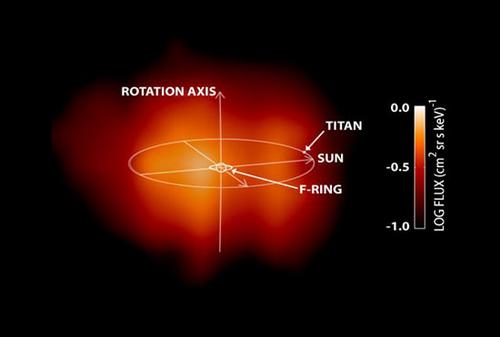
The image above, captured by the Cassini orbiter on June 21, 2004, represents the first direct look at the shape of Saturn's magnetosphere. The instrument used to obtain this view is the ion and neutral camera, one of three sensors that compose the magnetospheric imaging instrument. Saturn appears 3.7 million miles away from the camera ( around 6 million kilometers ). The Magnetospheric Imaging Instrument identified the hydrogen atoms ( represented in red ) that escape the Saturn magnetosphere. The emission from these hydrogen atoms are mostly located in the "suburbs" of the magnetosphere, probably beyond the orbit of Titan. Image Source: NASA /JPL
- To get further information on that news, go to: http://www.sciencemag.org/cgi/content/abstract/321/5895/1475, http://space.newscientist.com/article/dn14717-saturn-magnetises-its-moon-titan.html or http://saturn.jpl.nasa.gov/news/features/feature20080911.cfm.
August 18, 2008: Prebiotic Compounds may emerge in Titan's Cryovolcanoes
Titan is considered a natural laboratory for organic chemistry. Its atmosphere is probably very similar to the atmosphere of the early Earth before living organisms appeared and started to develop. The orange gas blanket of this Saturn moon is primarily composed of nitrogen which accounts for about 95% of its composition. The second most abundant compound is methane which represents up to 5% of its composition and that's one of the peculiarities which make this moon so captivating. The action of ultraviolet light helps generate the orange haze which makes the atmosphere opaque. A photolysis process via UV light takes place and a multitude of complex molecules are generated including hydrocarbons ( C2H6, C3H8, C2H2...) and nitriles.
Carl Sagan had proposed the name of tholin to characterize the orange organic haze. The heteropolymer tholin is based on the Greek word which means muddy. It is widespread on the surface and in the atmospheres of icy bodies in the outer solar system and it exists on comets as well. Tholins usually have a reddish-brown appearance. Titan tholins are likely nitrogen-rich organic substances.
What are the chemical processes occuring on the surface of Titan ? A new experiment sheds light on potential chemical reactions involving tholin and liquid water in geologically dynamic spots on Titan. The experiment was performed by Catherine Neish, a graduate student in planetary science at the University of Arizona. It consists in establishing the natural conditions in some locations of Titan where prebiotic compounds or complex organic molecules can be generated via the interaction of tholin and liquid water in a process called hydrolysis.
The specific spots on Saturn's biggest moon where this hydrolysis might occur are, probably, ice volcanoes and relatively recent impact craters. In Titan's harsh environment whose mean temperature is around -180°C ( -292°F or 93K ), these geologic phenomena are likely to generate or maintain enough energy to harbor liquid water, liquid ammonia or a mixture of both molecules long enough to allow reactions with complex organic molecules. Liquid water could persist for hundreds to thousands of years which is significant regarding the series of potential reactions it can allow.
In the experiment of Catherine Neish presented in the journal Astrobiology, a mixture of 95 percent nitrogen and 5 percent methane is exposed to electrical discharge at a low temperature (-78 degrees C ). Organic compounds were produced. The samples were, then, dissolved in water. At a range of temperatures from freezing up to 40 degrees C, she measured the rate at which the mixture hydrolyzed and observed that up to 10 percent of organic compounds she started with reacted with oxygen from the water to form complex organic substances. The experiment was conducted over a relatively short period that is, a few days.
The work of Catherine Neish undergoes some critics because the artificial environmental conditions in the simulation probably present a significant shift with reality. Dr. James P. Ferris, a research professor at Rensselaer Polytechnic Institute University and specialist of Titan who has led some research upon the chemistry of Titan's atmosphere for many years advances that Titan tholins are probably mostly generated by ultraviolet ( UV ) light and charged-particle radiation. So, the complex hydrocarbon molecules are rather the outcome of photolysis engendered by UV light instead of electric discharge via lightning.
That's what he had concluded on the basis of his experiments simulating Titan's atmosphere and showing up the action of UV light. He pointed out:" The structures of the compounds made by electric discharge differ from those formed by UV photolysis so the hydrolysis time could be very different. Some of the photochemical products ( When UV light is used ) are hydrocarbons that do not react with water."
Catherine Neish argues that electric or plasma discharge was, in fact, meant to simulate charged particle interactions. Dr. Ferris acknowledges that it is a process occuring on Titan. She admits, nevertheless, that UV light radiation generates tholins that look more like Titan's haze. She also points out that some, if not most, of the compounds they make also don't react with water.
Titan's environment is very hard to correctly reproduce. The gravity and the magnetic forces are different. Catherine Neish explains:" Tholins formed at low pressure seem to 'look' more like Titan's haze than those formed at higher pressures. You can make tholins at low pressures using UV light; you cannot make tholins at low pressure using plasma discharge. And to make the amount of tholins we needed for the experiment, we needed to use the discharge technique. UV photolysis only produces small amounts."
From an experimental point of view, the outcome of hydrolysis would be harder to analyse if the samples had been produced by UV light instead of electric sparks because of the small quantities obtained. The experiment of Catherine Neish was carried out using pure water for the hydrolysis of tholins which probably doesn't reflect reality. Indeed, Titan's icy crust is a fortiori made up of a mixture of water and ammonia. Eruptions of Titan's cryovolcanoes probably spread out both compounds. Therefore, lava flows may not be pure water. Catherine Neish recently finished another set of hydrolysis experiments using mixtures of ammonia and water. The results are expected to be published very soon.
Catherine Neish was probably inspired, in her work, by the famous Miller-Urey experiment that was supposed to reproduce the environment of the early Earth, presumably very similar to that of Titan, today. Prebiotic compounds and complex carbon-based compounds such as amino acids, sugars or lipids had been engendered from electrical sparks applied to a mixture of H2O, CH4, NH3, H2 and CO. The experiment of Catherine Neish confirms that very complex organic compounds can be naturally produced from basic molecules.
Where to find probiotic molecules ? The search for these complex molecules must focus on cryovolcanoes. The radar and infrared images of Titan reveal several circular features on its surface. It is always quite difficult to distinguish between impact craters and ice volcanoes. Yet, a round topographic feature has been clearly identified as a potential cryovolcano. The name of this potential cryovolcano is Ganesa Macula. The feature, 180 km wide, well above Xanadu and at a similar longitude as Hotei Arcus, is reminiscent of Venusian volcanoes, which are characterized as pancake-shaped domes.
Ganesa Macula exhibits a bright feature from an apparent central peak in radar images. The bright feature appears to represent a frozen lava river probably composed of water and ammonia. Has it reacted with tholins to form complex organic molecules or prebiotic substances ? Several other candidates, where one could look for liquid water and prebiotic molecules, can be spotted: one can mention Omacalt Macula above Fensal /Aztlan or Elpis Macula above the same region.
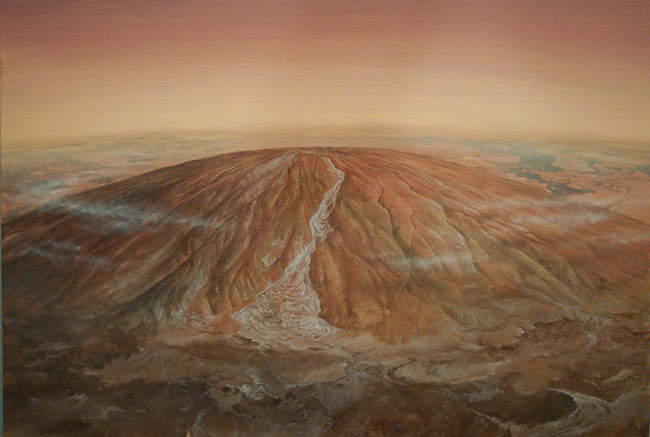
The artist's impression above, produced by Michael Carroll, represents the assumed Titanian cryovolcano, Ganesa Macula, clearly showing the frozen river of ice which represents the lava flow from the central peak of the pancake-shaped dome. This lava probably consists of a mixture of water and ammonia.© Michael Carroll
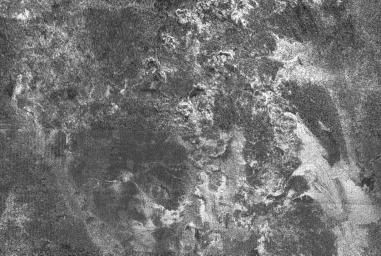
The radar mosaic above which was made from images captured by the Cassini synthetic aperture radar mapper on two flybys ( the flyby of October 26, 2004 for the lower part of the view and the flyby of January 13, 2007 for the upper part of the view ) reveals the circular geologic feature of Ganesa Macula ( in the lower left of the mosaic), interpreted as a cryovolcano or ice volcano with its presumed bright lava river of frozen ice. The mosaic is roughly 570 kilometers ( 354 miles ) wide and 390 kilometers ( 240 miles ) high and north is toward the top.
- To get further information on that news, go to: http://www.astrobio.net/news/modules.php?op=modload&name=News&file=article&sid=2841&mode=thread&order=0&thold=0
August 2, 2008: New Research confirms Ontario Lacus is a Lake, filled with Ethane
The south polar region of Titan may not be as wet as high northern latitudes, currently, but it shelters one of the biggest lakes or seas of the moon. That's the outcome of a new research led by astronomers and presented in the July 31 issue of the journal Nature.
The infrared images obtained with the Cassini's Visual and Infrared Mapping Spectrometer ( VIMS ) had revealed the presence of a dark, uniform patch in the south polar region. It has a kidney shape and it is very similar in shape and in size to the lake Ontario near Niagara Falls between Canada and the United States. Scientists concluded that this dark patch was likely a big lake or a small sea and it was given the name of "Ontario Lacus". This big lake or small sea extends 150 miles ( 235 kilometers ) and covers an area of roughly 7,800 square miles ( 20,000 square kilometers ). Imagine that this pool is just a little smaller than Mediterranean islands like Sicily or Sardinia.
The topographic features of the orange moon are particularly difficult to analyse because of the veil of the opaque, dense and deep atmosphere. The gas blanket mainly composed of nitrogen ( 95% of the total composition ) and hydrocarbon molecules ( around 5% of the total composition ) is completely opaque in the visible spectrum and it extends more than 620 miles ( 1,000 km ) above the moon's surface. Ontario Lacus was unveiled via infrared images which show a very absorbing patch consistent with a liquid surface. Thus, lakes and seas on Titan appear to be located, today, in high latitudes, both in the northern hemisphere and in the southern hemisphere. Prior to the Cassini-Huygens mission, scientists had postulated that Titan was covered with global oceans of methane, ethane and other light hydrocarbons. The Huygens probe and more than 40 Cassini flybys of the Saturn moon have shown that it is not an ocean moon and that the seas and lakes are not widespread and uniformly distributed.
The infrared analysis of Ontario Lacus based on the way it absorbs or reflects the incoming infrared light identify the presence of ethane and chemically different materials. The presence of water ice, ammonia, ammonia hydrate and carbon dioxide in Ontario Lacus is ruled out by scientists.
Bob Brown of the University of Arizona, Tucson and the team leader of Cassini's Visual and Infrared Mapping instrument pointed out:" This is the first observation that really pins down that Titan has a surface lake filled with liquid."
No radar images of Ontario Lacus have been obtained, yet. Nevertheless, even if radar data are useful in spotting pools of liquids, they must be examined carefully because it's delicate to distinguish between liquid and very fine gravel or other tiny solids as Brown explained.
The infrared analyses identify three key-characteristics of Ontario Lacus which show it's a lake: the shoreline or the outer edge of the lake which appears bright, the beach appearing dark just inside the shoreline which probably corresponds to the material left behind as the ethane mixture evaporated and the lake's content or the dark patch which is the liquid hydrocarbon mixture.
Robert Brown gave his impression upon the lake to space.com: " It seems to have partially evaporated, and that makes sense because the south pole has just gone through summer... The maximum evaporation will have already occured or is in the process of occuring." He added:" There's still a lot of liquid left in that lake, and we don't think it's going to evaporate much further."
Larry Soderblom, a Cassini interdisciplinary scientist with the U.S. Geological Survey in Flagstaff, Arizona pointed out:" Detection of liquid ethane confirms a long-held idea that lakes and seas filled with methane and ethane exist on Titan." He argued:" The fact we could detect the ethane spectral signatures of the lake even when it was so dimly illuminated , and at a slanted viewing path through Titan's atmosphere, raises expectations for exciting future lake discoveries by our instrument."
Liquid ethane was found using a technique that removed the interference from the atmospheric hydrocarbons. One can suppose that the ethane content of Ontario Lacus derives from the breakdown of methane or other hydrocarbon molecules which recombine to form new molecules such as C2H6 or C2H2. The breakdown is triggered by the action of sunlight, especially ultraviolet light via a process called photolysis. Ontario Lacus may be replenished by a drizzle of methane or ethane and the photolysis process may result in the condensation of ethane molecules to form the lake and replenish it.
What would a cosmonaute feel if he went swimming with the adapted spacesuit ? Robert Brown explained:" Liquid ethane-methane mix would be less viscous than water... If riffling your fingers through it you wouldn't feel as much resistance."
Larry Soderblom argued:" During the next few years, the vast array of lakes and seas on Titan's north pole mapped with Cassini's radar instrument will emerge from polar darkness into sunlight, giving the infrared instrument rich opportunities to watch for seasonal changes of Titan's lakes."
Professor Ralf Jaumann of the DLR Institute of Planetary Research ( DLR-Institut fur Planetenforschung ) in Berlin who took part in the study upon Ontario Lacus is not surprised by the finding. He led a second research project focusing on widely branched valleys in other areas of Titan and he argued:" These can only have been created under the influence of stream erosion."
Branching networks were clearly observed from the parachuted Huygens probe on 14 January 2005, on hills close to what seemed to be a shoreline, similar to what we could see on the French Riviera near Nice.
Ralf Jaumann pointed out:" In the meantime, we have discovered such valley systems in many other places on Titan by using the spectrometer and the radar instrument." He added:" Our analyses show that at least from time to time, considerable amounts of liquids must have flowed through these valleys."
It's likely that up to 1600 cubic metres of liquid per second could have flowed through the rifts which corresponds to about two thirds of the amount of water flowing from the Rhine into the North Sea.
Two possibilities for the origin of the fluid are considered: the first hypothesis is that it has a subsurface origin meaning that it is cryovolcanic in nature. The second hypothesis is the meteorological hypothesis. In this second case, it rains methane and / or ethane, simply. Ralf Jaumann argued:" We are inclined to consider precipitation as the most likely source of the liquids, as the branched valley systems extend over wide areas and do not originate from single sources, but the question can only be answered conclusively by further measurements, which we have planned during the next two years."
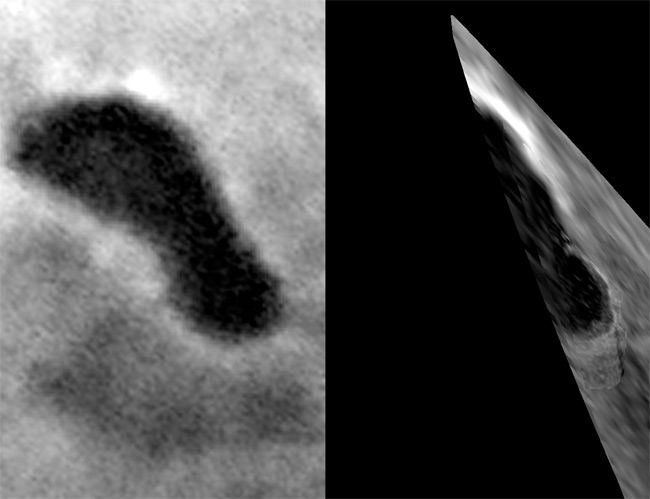
The mosaic of infrared images above shows the dark patch Ontario Lacus in Titan's south polar region. The right image taken 1,100 km away ( 680 miles away ) from the Cassini spacecraft only shows a portion of the ethane lake and it clearly reveals an eroded area reminding of a giant beach along the lower shoreline. Probably that it is a surface area appearing as a former extension of the lake which has completely or partly evaporated. The left image of the lake was captured in June 2005. Image source: NASA/JPL/Space Science Institute ( left image ), NASA/JPL/University of Arizona ( right image )
- To get further information on that news, go to: http://www.space.com/scienceastronomy/080730-titan-lake.html, http://saturn.jpl.nasa.gov/news/press-release-details.cfm?newsID=858 or http://www.saturndaily.com/reports/Complex_Liquid_Hydrocarbon_World_Unveiled_On_Saturns_Titan_999.html
May 27, 2008: Titan Dunes may be produced by Organic Haze
New observations made with the Cassini spacecraft suggest that the equatorial dunes of the Saturn moon Titan are probably made up of organic materials resulting from the haze. The Visual and Infrared Mapping Spectrometer ( VIMS ) allowed scientists to study, in depth, the linear, longitudinal dunes that stretch along the equator. The analysis of the VIMS images of the T20 flyby shows that the spectrum of the dune endmember implies a sand composed of less water ice than the rest of Titan. The dunes' measured reflectivity is consistent with various organics.
The finding regarding the relative lack of water ice compared to the rest of Titan is reported in the May 2008 issue of the journal Icarus. The dark brown sands seem to consist of the same kind of complex organic compounds that dominate Titan's smoggy atmosphere. The Seif dunes of Titan were discovered as soon as 2005 by the Cassini spacecraft. The radar views unveiled dark parallel lines stretching over long distances along the equatorial region. They were called "cat scratches".
If those giant ergs or dune fields are fully composed of the same material, one can advance that the erosion process is insufficient to explain the formation of such topographic structures. On Earth, sand is the outcome of erosion pocesses. Sand can be found in deserts and in coastal areas. The sand dunes in deserts like Sahara appear on ancient seas or lake beds. The beaches along seas or oceans can be made of sands with various materials and appearances. In Hawaii, for instance, one can encounter pink sand beaches composed of coral sediments, black sand beaches made of dark volcanic basalt as well as green sand beaches due to the presence of olivine. In southern Europe, one can find yellow sand beaches due to iron impurities in the quartz crystals of the sand. Most sand formations on Earth are dominated by silicate. The most common constituent of sand is silicon dioxide ( SiO2 ), usually in the form of quartz. Some dunes can have a very different nature like the gypsum sand dunes of the White Sands National Monument in New Mexico which are famous for their bright, white color. Some sands contain magnetite, chlorite, glauconite, obsidian or olivine which will give them a unique appearance.
On Titan, the dunes are likely dark, brown composed of organics originating from the environmental haze. The size of the sand grains is expected to be between 0.18 and 0.25 millimeters because it is a perfect size for being transported by the wind forces and drifting into dunes. Geologists consider that the typical diameter of sand grains ranges from 0.625 to 2 millimeters. The scientists assume that smog particles grow together into larger grains via a process called sintering. One can note that in the atmosphere, the particles are tens of millions of times smaller than we think the sand grains are. In the process of sintering, particles are warmed enough to stick together.
The linear shape of the longitudinal, parallel dunes of Titan is apparently due to prevailing winds which generate Seif dunes, a variety of dune fields appearing in the Sahara, in the Namib desert or in the Arabian Peninsula ( notably between Yemen and Saudi Arabia ). Surprisingly, the average spacing between the ridges or the crests of the dunes is similar to the terrestrial Seif dunes, notably in the Namib desert. The dune spacing averages about 2.1 km ( 1.3 miles ) on Titan and the crests are parallel to the average wind direction: the dunes are oriented on the average in an east-west direction, but angling up to 10° from parallel to the equator in specific cases.
The dunes are probably about 100 meters high ( 328 feet ) on average. By comparison, in the Sahara, Seif Dunes range up to 300 meters ( 900 ft ) in height and 300 km ( 200 mi ) in length. In the Arabian Peninsula, the Rub al Khali conatins Seif dunes stretch for almost 200 km and can be higher than 300 meters ( over 900 feet ).
In a research paper entitled "Spectroscopy, morphometry, and photoclinometry of Titan's dunefields from Cassini / VIMS" in the May 2008 issue of the journal Icarus, Jason W. Barnes and his collaborators point out that the huge quantity of sand in the equatorial region comprises less water than the rest of Titan and that the measured reflectivity tends to show the presence of organics or hydrocarbons. Jason W. Barnes advanced: "So while river channel erosion may play a role in the formation of Titan's sand , the process is evidently more complicated than we had originally envisioned, and river erosion isn't the whole story."
Marc Lafferre notes that other factors than organic haze can be considered. A major potential factor is related to Titan climate in the equatorial region. The meteorology can greatly vary over the Titan year which lasts approximately 30 Earth years. What happens to the surface if each year, the area undergoes massive flooding or "monsoon" followed by massive droughts accompanied by strong winds. Over time, over eons, the erosion process could be significant. In that case, the formation of those Seif dunes could also be explained, partly or fully.
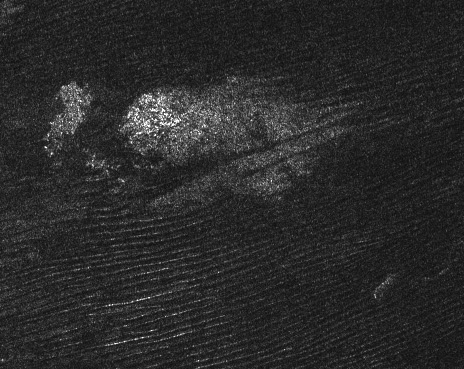
The radar portion above was obtained by the Cassini spacecraft during the T8 flyby on October 28, 2005 which scanned the equatorial region. It clearly unveils the Seif, longitudinal dunes as well as the strong impact of the prevailing winds on landforms. What are the dune fields made of ? How did the sand appear ? Is the sand formation process similar to what we encounter on Earth ? Image source: NASA, JPL; Special thanks to Jason Perry of the Cassini Imaging Team for his webpage bringing together Titan radar images: http://pirlwww.lpl.arizona.edu/~perry/RADAR.
To get further information on that news, go to: http://saturn.jpl.nasa.gov/news/features/feature20080502.cfm
March 31, 2008: New Data reveals a Moving Crust probably Hiding an Underground Ocean
New observations gathered by the Cassini spacecraft during several Titan passes imply the potential presence of a deep underground ocean beneath the solid external shell of Titan. Specialists have long suspected the existence of a subsurface liquid layer mostly composed of a mixture of water and ammonia below the icy crust of this Saturn moon.
Now, they are more convinced than ever. Why ? because the crust has apparently moved, significantly, during a 1.5 year period. The findings were made using radar measurements of Titan's rotation. The Cassini scientists used the Synthetic Aperture Radar onboard the Cassini probe to collect imaging data during 19 separate passes over Titan between October 2005 and May 2007. The radar images allowed the scientists and radar engineers to identify the locations of 50 unique landmarks on the moon's surface such as lakes, canyons and mountains. By analysing the reams of data transmitted by the Cassini spacecraft in its later Titan flybys, they noticed prominent surface features had shifted from their expected positions by up to 30 kilometers ( 19 miles ).
Apparently, Titan spins an extra 0.36 degrees over the course of a year beyond what it was expected to do on the basis of basic models and the moon's rotation turns out to be slowly increasing. The apparent displacement of topographic features in a short period of time led scientists to assume that the external crust of Titan is decoupled from its core by an internal ocean, making it easier for the crust to move.
Ralph Lorenz, lead author of the paper and Cassini radar scientist at the Johns Hopkins Applied Physics Laboratory in Laurel, Maryland pointed out:" With its organic dunes, lakes, channels and mountains, Titan has one of the most varied, active and Earth-like surfaces in the Solar System." He added:" Now we see changes in the way Titan rotates, giving us a window into Titan's interior beneath the surface."
Scientists suspect the presence of a liquid layer up to 300 kilometres thick beneath the icy crust. The subsurface ocean is probably sustained by the presence of ammonia which acts as an antifreeze.
Bryan Stiles of Nasa's Jet Propulsion Laboratory in Pasadena, California, a contributing author to the paper regarding the finding which appears in the March 21, 2008 issue of the journal Science said:" We believe that about 100 kilometers ( 62 miles ) beneath the ice and organic-rich surface is an internal ocean of liquid water mixed with ammonia."
Probably that the presumed internal ocean has gathered and preserved heat from the moon formation and the decay of radioactive material which should have melted much of this water to generate an ocean. Titan has a very low density: the mean density is around 1.8 g/ cm3 which pushes scientists into postulating that Titan is composed of a combination of water and rock, water accounting for 50% of its mass.
Titan's dense, thick and deep atmosphere ( around 1.5 bars at surface level ) is likely to have a significant impact on crustal displacements. Since the moon's outer layer is probably floating on an internal ocean, it is easily understandable to suppose that the winds influence and push the external ice shell. If the orange moon were solid from surface to core, it would be much more difficult for winds to change Titan's rotation.
Gabriel Tobie of the University of Nantes in France confirms that the data are consistent with the hypothesis of a liquid layer but he notes that it is not a definitive proof. He claims that changes in the inclination of the moon's rotation axis over thousands of years could also explain the observed shift. Nevertheless, Bryan Stiles argues that the data they have gathered are sufficient to validate the hypothesis that the shift is linked to changes in spin rate rather than to the movement of the pole.
The gravitational fields of Saturn and other nearby planets and moons were taken into account in the pre-Cassini model of Titan's spin but they don't explain this apparent topographic shift. Thus, one of the key elements appears to be the seasonal changes in the motion of its atmosphere. The winds are low energy phenomena but on a "disconnected" crust which slides on a liquid layer, they are likely to have a strong influence.
It is very captivating to imagine that Titan harbours liquid water and complex organic molecules and generates tidal heating. Ralph Lorenz insisted:" The combination of an organic-rich environment and liquid water is very appealing to astrobiologists." He added:" Further study of Titan's rotation will let us understand the watery interior better, and because the spin of the crust and the winds in the atmosphere are linked, we might see seasonal variation in the spin in the next few years."
John Zarnecki, professor of Space Science, at the UK's Open University notes that the key compounds for the chemistry that leads to life are present on Titan. Life could emerge in geothermal vents. Professor Zarnecki concludes:" We've got to go back again with balloons and rovers and really understand this place."
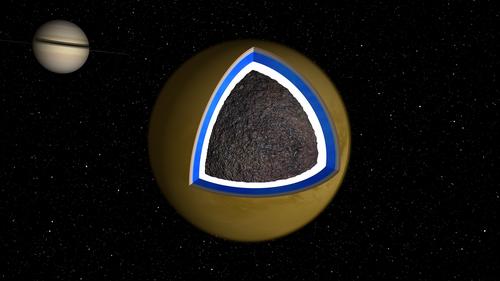
The diagram above shows a cross-section of Titan which reveals what is believed to be its internal structure: the icy crust might hide a very deep water-rich ocean covering a solid core. Image Source: NASA, JPL
To get further information on that news, go to: http://saturn.jpl.nasa.gov/news/press-release-details.cfm?newsID=826, http://news.bbc.co.uk/2/hi/science/nature/7307584.stm or http://space.newscientist.com/article/dn13516-titans-changing-spin-hints-at-hidden-ocean.html
February 15, 2008: New Estimates for the Amount of Surface Organics on Titan: Out of this World !
After almost 4 years of intense study of the Saturn System, the Cassini spacecraft is progressively unveiling the topography of Titan's surface. In spite of the huge amount of data gathered by the orbiter, only about 20 percent of Titan's surface has been mapped with radar. Contrary to what some scientists had thought or suggested, Titan is not an "ocean-moon": the infrared and the radar data tend to indicate that the low latitudes are mostly dry. No seas or lakes have been clearly identified in the equatorial regions. On the other hand, the radar mapper has allowed scientists to identify a myriad of lakes in Titan's polar latitudes. So far, only two lakes have been spotted in the south pole but the next radar passes of that area should confirm more lakes.
Most of the liquid pools we've clearly spotted are situated above 70 degrees north latitude. One of the bodies of liquid is so big that there is a debate over whether we should call it a sea or a lake.
A new study led by Ralph Lorenz, Cassini radar team member from the Johns Hopkins University Applied Physics Laboratory, Laurel, Md. focuses on the inventory of organic surface materials on Titan. It is reported in the January 29 issue of the Geophysical Research Letters. The estimate takes into account polar lake liquids and equatorial dune sands which are presumed to be organic, to be made up of carbon molecules.
One of the conclusions is that the orange moon has hundreds of times more liquid hydrocarbons than all the known oil and natural gas reserves on Earth. And dark dunes, supposed to be composed of organics and covering 20% of Titan's surface, comprise a volume of material several hundred times larger than Earth's coal reserves. Overall, over 30,000 km3 of liquid and 200,000 km3 of dune sands are estimated to be present on Titan on the basis of what has been mapped so far.
Ralph Lorenz said: "Titan is just covered in carbon-bearing material... It's a giant factory of organic chemicals... This vast carbon inventory is an important window into the geology and climate history of Titan."
The surface of Titan remains enigmatic to a large extent: the equatorial dunes are thought to consist mostly of complex organic molecules. These uncommon molecules have been named "tholins", a term imagined by Carl Sagan in 1979 to describe the complex organic molecules at the heart of prebiotic chemistry. The lakes and seas in the northern latitudes are supposed to be made up of methane and ethane.
Several hundred lakes or seas have been spotted and dozens of Titan's lakes contain individually the equivalent of the proven reserves of natural gas on Earth ( 130 billion tons ) which is enough to provide 300 times the amount of energy the entire United States uses annually for residential heating, cooling and lighting. Let's recall that at around -179 degrees Celsius or -290 degrees Fahrenheit, methane and ethane appear in their liquid state.
Ralph Lorenz pointed out: " This global estimate is based mostly on views of the lakes in the northern polar regions. We have assumed the south might be similar, but we really don't yet know how much liquid is there."
One of the key parameters in the analysis is the mean depth of bodies of liquid. The radar scan doesn't bring any significant information on the depth of lakes except where they are very shallow. A fortiori, the darker the pool in radar images , the deeper it will be. Due to these technical constraints, scientists made some general assumptions based on lakes on Earth. They made some extrapolations: they took into account the average area and depth of lakes on Earth, as well as the nearby surroundings like mountains. Thus, they noticed that the terrestrial lake depth is often 10 times less than the height of nearby terrain.
Ralph Lorenz explained:" We also know that some lakes are more than 10 meters or so deep because they appear literally pitch-black to the radar. If they were shallow we'd see the bottom, and we don't." Marc Lafferre, an independant researcher, notes that the mean depth of 15 major lakes on Earth is roughly 250 meters. If Titan's northern lakes are as deep as major terrestrial lakes, the hydrocarbon reserves of this Titan wetland would represent at least 650 times the proven hydrocarbon reserves of the Earth.
The concentration of methane on the surface and in the atmosphere of Titan is surprising because it only lasts a few million years due to a photolysis process. The ultraviolet light breaks down methane molecules which recombine to form other molecules ( C2H6, HCN, C2H2...) or escape into space. That's the reason why scientists believe that methane might be supplied to the atmosphere by venting from the interior in cryovolcanic eruptions. Because if it's not the case, methane should have disappeared from the atmosphere. If the methane molecules emerge from Titan's interior, it's likely that the apparent meteorological cycle of methane will be insufficient to sustain the amount of methane: this greenhouse gas might disappear and trigger a global cooling down on this moon.
Probably that Titan has experienced dramatic changes in its climate. If the interior supplies the surface and the atmosphere with methane, we can postulate that the concentration of methane was higher in the past. But a higher concentration of methane can be accompanied by warmer temperatures via greenhouse effects, a process which could trigger a higher unstability in the atmosphere with a higher amount of gases escaping from its atmosphere. So is there an equilibrium in Titan's atmosphere ?
Beyond this question, Lorenz reminds the interesting side of the chemistry occuring in that environment: " We are carbon-based life, and understanding how far along the chain of complexity towards life that chemistry can go in an environment like Titan will be important in understanding the origins of life throughout the universe."
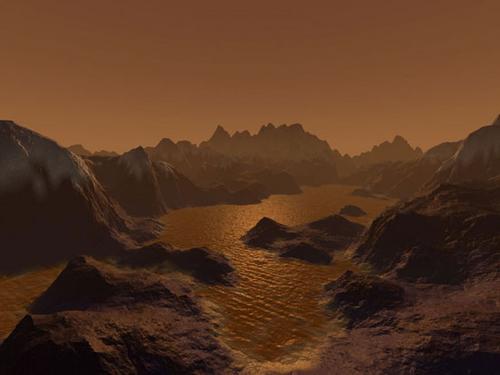
The artistic rendering above reveals some hydrocarbon pools in Titan's wetlands. A rocky terrain covered with ice dominates this area. Image source: Steven Hobbs.
To get further information on that news, go to: http://saturn.jpl.nasa.gov/news/press-release-details.cfm?newsID=814 or http://www.agu.org/pubs/crossref/2008/2007GL032118.shtml
January 9, 2008: Significant Mountain Ranges and Heavy Negative Ions in Titan's Upper Atmosphere confirmed
Infrared and Radar data gathered by the Cassini spacecraft reveal the high complexity of Titan's topography. Among the surprises, one can mention the presence of a Mountain Range in the bright region of Xanadu. This range is almost 150 kilometers ( about 93 miles ) long and 30 kilometers ( just under 20 miles ) wide and the mountains are roughly 1.5 kilometers high ( around 5000 feet ).
Jani Radebaugh, a planetary scientist, is lead author of a paper regarding the Radar analysis of mountains in the December issue of the astronomy journal Icarus. She said: " Since this is the first time humans have been able to see through the haze to Titan's surface, it was shocking to find these mountains, channels, dunes, and cryo-lava flows...We had to wait until we got all the way to Titan to see these landforms that are similar to Earth."
The mountains height was inferred by looking at the light and shadows in the radar images. The radar mapper shows elevated blocks and ridge-forming block chains. Topographic ridges measured from the T3 ( February 2005 ) and T8 ( October 2005 ) flybys have a mean maximum slope of 37° and total elevations up to 1930 m as derived from a shape from-shading model corrected for the probable effects of image resolution.
Titan's mountains are most likely composed of water ice and don't exceed 2 km high ( 1.25 miles ) from base to peak. A high level of erosion and the nature of the material covering the mountains are likely to prevent the mountains from growing higher. Doctor Jason Barnes, a research scientist at the NASA Ames Research Center, pointed out:" Her discovery tells us about the mountain-building process in general and about Titan's crust in particular."
What is the origin of the mountains on Titan ? It was assumed, first, that most mountains on Titan would be the outcome of meteoritic impacts with higher topography along the rims of the impact basins like on our moon. But, here, geological processes might be at work. On Earth, several processes can be distinguished in forming mountain ranges: first, ocean-continent subduction when ocean plates, denser than continental plates, crash into continental plates. The Andes and the Rockies are the outcome of that geological process. Second, continent-continent subduction when continental plates collide into each other. For instance, the Alpes derive from the encounter of the European Plate and the Eurasian Plate. The Himalaya was formed via the collision of the Indian Plate and the Eurasian Plate. Third, ocean-ocean subduction when two ocean plates collide into each other, accompanied by volcanic activity. An example is the Pacific Ring of Fire in the Pacific Ocean. Fourth, Ocean Rifts when the plates pull apart or break. The result is a Horst-and-Graben topography that is a block of land sliding down. The Rift of the Red Sea is an example of that phenomenon. Lava and hot spots appear. The Island of Hawaii or the Hoggar Mountains ( Sahara ) are the results of hot spots. If a tectonic plate moves over hot spots, volcanic chains develop.
Doctor Radebaugh advances four possible explanations for the emergence of the Titan mountains. The first hypothesis is that the mountains were thrust up from crustal compression, horizontal forces smashing the crust together and upward. The second hypothesis is that Titan's mountains may have developed through spreading or separation of the crust. The third hypothesis is that the mountains result from a meteoritic impact that expelled surface material. The fourth possibility is that the high topographic features result from an erosion process which removed some material from the surface layer.
Jani Radebaugh also pointed out that Titan possesses the primary ingredients for life, that is water, organics, nitrogen as well as CO2. In a way, Titan is a "prebiotic laboratory". She explained:" We still don't understand exactly how life began on Earth, so if we can understand how the fundamentals of these processes may be starting in some laboratory like Titan, it will help us understand the Earth a lot better."
The complexity on Titan goes beyond topographic characteristics. The atmosphere is also very complex with a multitude of haze layers. The gas blanket is mostly composed of nitrogen. But also, a high concentration of hydrocarbons is present. Methane is the second most abundant gas. Other carbon-made molecules are also present including heavy negative ions in the upper atmosphere. These particles may act as organic building blocks for even more complicated molecules.
Professor Andrew Coates, researcher at UCL's Mullard Space Science Laboratory pointed out:" Cassini's electron spectrometer has enabled us to detect negative ions which have 10,000 times the mass of hydrogen. Additional rings of carbon can build up on these ions, forming molecules called polycyclic aromatic hydrocarbons, which may act as a basis for the earliest forms of life. The findings were published on November 28, 2007 in Geophysical Research Letters. He added:" Their existence poses questions about the processes involved in atmospheric chemistry and aerosol formation and we now think it most likely that these negative ions form in the upper atmosphere before moving closer to the surface, where they probably form the mist which shrouds the planet and which has hidden its secrets from us in the past. It was this mist which stopped the Voyager mission from examining Titan more closely in 1980 and was one of the reasons that Cassini was launched."
Complex hydrocarbon molecules including Tholins form the haze which makes its atmosphere opaque. Doctor Hunter Waite of the South West Research Institute in Texas advanced:" Tholins are very large, complex, organic molecules thought to include chemical precursors to life. Understanding how they form could provide valuable insight into the origin of life in the solar system."
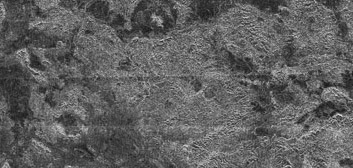
The radar view, above, corresponds to a portion of the radar swath obtained during the T13 Flyby on April 30, 2006. During this flyby, an equatorial pass was performed by the radar mapper showing the leading hemisphere , Central Xanadu, Eastern Shangri-La, Guabonito as well as Shikoku Facula. This view reveals the complex topography with plains,hills and elevated terrain.
- To get further information on that news, go to: http://www.saturndaily.com/reports/Unveiling_The_Mountains_Of_Titan_999.html, http://www.ucl.ac.uk/media/library/OrganicBuildingBlocks